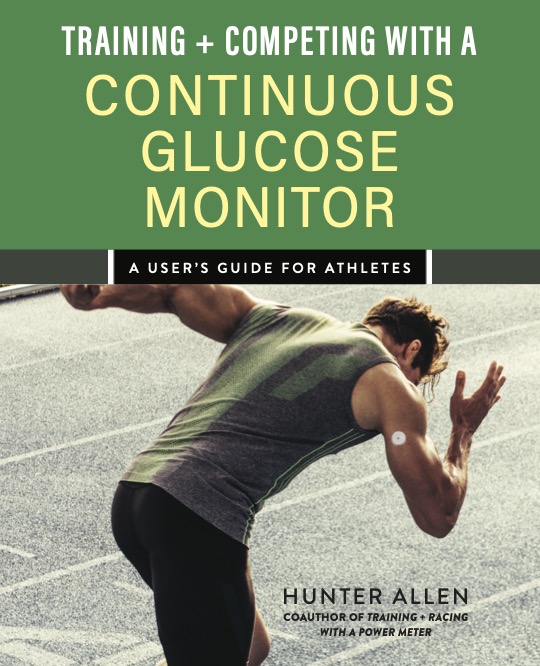Book Review: Training and Competing with a Continuous Glucose Monitor by Hunter Allen

Hunter Allen’s Training and Competing with a Continuous Glucose Monitor sets out to be exactly what its subtitle claims: a “user’s guide for athletes.” The text is a well-structured, practical, and data-rich manual for athletes who want to integrate Continuous Glucose Monitors (CGMs) into their training and racing and delivers exactly what it promises. If you pick up the book hoping to understand how to interpret your glucose readings, identify patterns and tweak your nutrition for training, racing and recovery strategies, you’ll walk away satisfied. Allen frames CGMs as the next game-changing technology for sport and well-being, citing a lack of knowledge as the reason the revolution hasn’t begun. But will CGMs revolutionize the sport? This reviewer remains unconvinced.
Strengths: Clear, Practical, and Thorough
One of the book’s biggest strengths is its clarity. Allen, a former pro cyclist turned coach and co-founder of WKO (which turned into TrainingPeaks), writes in a plain, coach-like voice that makes complex physiological concepts approachable. His breakdown of terms like “glycogenolysis,” or “insulin sensitivity,” is refreshingly jargon-free, yet technically sound. Allen is especially great at combining his expertise in data analysis with anecdotal evidence and presenting it alongside easy-to-understand graphs.
The content is logically organized, beginning with what a CGM is, how it works, and how to get started. Later chapters cover optimizing glucose for training and racing, using CGMs for recovery, and there is a dedicated section for athletes with diabetes.
Throughout, Allen emphasizes the variability of glucose responses — between individuals, across training phases, and even within the same person on different days. Acknowledging the volatility of real-world data is welcome in a space that often oversimplifies metrics into one-size-fits-all. The book also goes into the deep trenches, detailing behaviours like meal stacking.
The case studies, graphs, and anecdotal experiences make the material tangible. It’s easy to see how wearing a CGM could help an athlete recognize mid-ride energy dips, avoid certain foods before competition, better manage recovery nutrition, and, as Allen points out, even assist in general health and long term vitality.
But Is This a Revolution for Athletes?
Allen successfully identified how power meters would change cycling and performance and his book Training and Racing with A Power Meter and work to co-found WKO (TrainingPeaks) in the late 90s and early 00s, which makes his opinion on CGMs worth noting. But, while the book delivers what it promises and he is crystal clear about the book’s scope, the underpinned notion that CGMs will be the next revolutionizing technology in sport is questionable.
So, I asked him the question: Considering the rise and drop-off of CGMs about three years ago, when every athlete and their dog seemed to be running a sensor, was it ahead of its time or was it not all it cracked up to be?
“I think you nailed it on the head, it was a little ahead of its time…there wasn’t that basic knowledge of how to use it,” he says. “And so [Supersapiens] worked really hard at trying to bring that information to it. But again, there just wasn’t the manual. There wasn’t the how-to, there wasn’t the user guide. Like, what do I do with this information?…So I think a lot of people tried it and they just saw these squiggly lines and thought ‘I don’t know what it means.’”
Just as he did with power meters, his new book is a response to his real-life coaching experience and aims to empower people to understand CGMs, analyze the data, and make better decisions to achieve higher performance.
But, CGMs aren’t changing the science of endurance sports to unlock unknown performance. The same nutrition fundamentals and timing concepts apply— with or without a CGM. Allen actually agrees and says CGMs are more of a behavioral change device.
“Putting a power meter on your bike doesn’t make you go faster,” he explains. “Putting a CGM in your arm does not make you go faster. It does not make you not bonk. It doesn’t make you any of those things. You have to pay attention to the information and then make appropriate decisions about that information.”
I further ask him about the potential for disordered eating and negative consequences which he addresses with care, ultimately saying CGMs aren’t for everyone. We also discuss the cost, which can add up since the sensors typically only last two weeks and often fall off.
“You could read my book and never use a sensor and gain a ton of knowledge about how to basically monitor glucose as an athlete and do the steps that will make you even better as an athlete,” he says.
He recommends six months of data collection to start seeing trends and understanding your personal profile, and that’s where we find some common ground. A focused period of wearing a sensor and understanding what’s going on in your body before, during and after training is informative and can be impactful but, as all the athletes I’ve spoken to (including two world champions, former CMG sponsored athletes, and elite coaches) about their CGM experience confirmed: once that short learning experience is over, wearing a sensor doesn’t continue to add value.
Now, once the technology of a continuous lactate monitor is available–that book just begs for Allen’s pen.
A Useful Tool, Not a Silver Bullet
Training and Competing with a Continuous Glucose Monitor is an informative, well-structured resource for athletes curious about CGMs. It will teach you how to use the device effectively, interpret your data, and make smarter fueling decisions.
However, CGMs won’t replace foundational training and nutrition principles, they won’t work magic on performance, and for many, their use will be temporary due to cost and practicality. CGMs and understanding them with the help of Allen’s book is great for a focused learning period, but not a prolonged necessity.
Rating: ★★★☆☆ (3/5) – Recommended for athletes curious about CGMs, with the understanding that the biggest benefits come from awareness and habit change.




Start the discussion at forum.slowtwitch.com